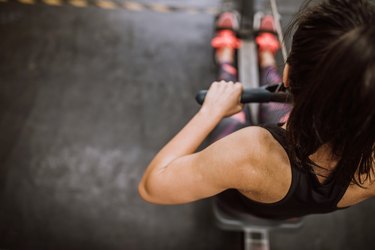
The rowing machine might not be as popular as the treadmill at your gym, but rowing is a great alternative to running for your workout. Not only does rowing burn calories and strengthen your heart, it also offers other benefits that running doesn't.
When comparing rowing vs. running, rowing might be a better option for you — especially if you're looking for a low-impact exercise or one that will also strengthen your upper body.
Video of the Day
Video of the Day
Whether you choose rowing vs. running, aim to get 150 minutes of moderate-intensity aerobic activity or 75 minutes of the same per week, as recommended by the Centers for Disease Control and Prevention. To lose weight, you will need to increase your exercise time beyond this minimum recommendation.
Read more: Benefits of a Rowing Machine
Tip
While rowing and running are both calorie-torching exercises, rowing targets muscles in your upper and lower body while running focuses on your lower body.
Rowing vs. Running: Muscles
Most of the muscles you use in running are in your lower body: your quads, hamstrings, glutes, hip flexors and calves. Your abs and biceps serve as supporting muscles and are strengthened to a lesser degree.
When you row, however, both upper-body and lower-body muscles serve as your primary movers, and you strengthen many more muscles than when running. In addition to your calves, hamstrings, quadriceps and glutes, you strengthen your abs and erector spinae in your core, and your deltoids, biceps and brachioradialis in your arms as you pull. Your forearms also get a workout as you grip the rower's handle.
Kinder to Your Joints
Unlike running, rowing is both low-impact and non-weight bearing, so it causes less wear and tear on your joints. This is especially important if you have weak joints or arthritis. Of course, as with any exercise, it can be harmful to your joints if you do not maintain proper form.
When rowing, push off with your entire foot, including your heels, and not just with your toes. This will prevent strain on your knee joints.
Read more: 17 Reasons to Start Running
Your Calorie Burn
You will burn calories using a rowing machine, but not as many as when running. According to the American Council on Exercise, a 150-pound person burns approximately 158 calories in 30 minutes rowing at a moderate pace, but burns 181 calories in the same amount of time running at a pace of 5 miles per hour.
Make the Most of It
Always begin your workout with a five- to 10-minute (or longer) warm-up to prepare your muscles and cardiovascular system for the work ahead. Always end your workout with at least a five- to 10-minute cool down to return your body to its pre-workout state.
Begin slowly with a lower resistance and gradually increase the intensity once you feel comfortable with the movement. Maintain proper form, with back straight and shoulders back to prevent excess stress on your back. Stop exercising if you become too tired to maintain proper form.
- American Council on Exercise: "Physical Activity Calorie Counter"
- ExRx.net: "Row Ergometer"
- ExRx.net: "Basic Types of Runs"
- Centers for Disease Control and Prevention: "Physical Activity for a Healthy Weight"
- American College of Sports Medicine: Selecting and Effectively Using a Rowing Machine
- Concept2.com: Indoor Rowers / Training / Technique Videos
- American Council on Exercise: What’s the Best Piece of Cardio Equipment to Use?
Was this article helpful?
150 Characters Max
0/150
Thank you for sharing!
Thank you for your feedback!